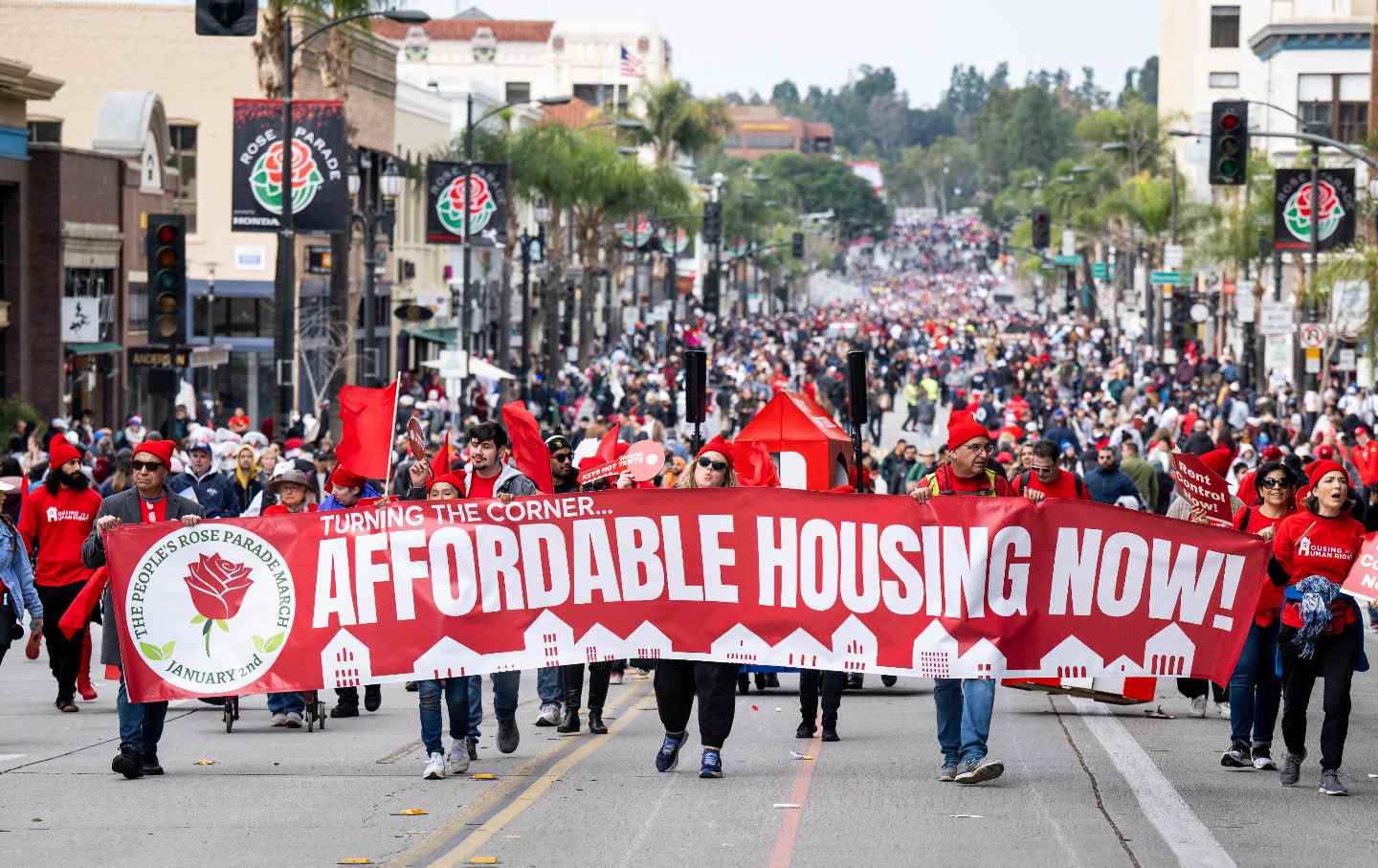The Future of Rent Control Is on the Ballot in California
Proposition 33 could overturn the controversial Costa-Hawkins Rental Housing Act, which has limited rent control policies in the state for decades.

The People’s Rose Parade protests for more affordable housing and rent control in Pasadena, California.
(Sarah Reingewirtz / Getty)
Berkeley resident Leah Simon-Weisberg says that she might have to leave California after her daughter graduates from high school.
“We moved to Berkeley to be closer to family and access to good public schools, but [because of this] we lost our rent controlled apartment we loved in Los Angeles,” said Simon-Weisberg, who is also the executive director of the California Center for Movement Legal Services. “Every time I’ve had to move, I’ve had to pay double the rent. I cannot move and not risk financial insecurity, but you have to make choices when you have a child.”
Simon-Weisberg’s story is common in California, where an affordable housing crisis has spun out of control. Rent control policy in the state remains restricted by the controversial Costa-Hawkins Rental Housing Act, a 1995 law that prohibits local jurisdictions from establishing rent control on all single-family homes and houses completed after February 1, 1995. This includes a prohibition on vacancy control, which allows landlords to reset rents when new tenants move in, contributing to the drastically higher rates Simon-Weisberg has confronted each time her family moves.
This November, the future of rent control policy is on the ballot for Californians in the form of Proposition 33. If passed, Prop 33 would repeal the act—a move Simon-Weisberg hopes would help stabilize rents for herself and all California tenants.
According to researchers at the University of California, Santa Cruz, opposition to rent control in California, and across the nation, began at around the same time advocates of rent control began organizing during World War II. These efforts took off in the 1970s, researchers say, after the City of Berkeley passed a rent-stabilization ordinance. In retaliation, organized landlords began working toward making rent control a state issue, forbidding local jurisdiction from passing protections. Costa-Hawkins became their most prominent victory.
“This type of law is not unique to California,” said Lorraine Lopez, senior attorney at the Western Center on Law and Poverty. Around 30 states have some form of state preemption of local rent control.
According to Lopez, serious efforts to organize against Costa-Hawkins began around 2016 when the cities of Richmond and Mountain View passed new rent control ordinances for the first time in decades. In 2018, the chair of California’s State Assembly Committee on Housing and Community Development introduced AB 1506 to repeal Costa-Hawkins.
Today, debates over rent cap policy are particularly salient, as the state faces high housing inflation and increased homelessness. “We have this law on the books that—pretty early in our rent cap journey—came out to really effectively stymie the ability of local governments to address their own housing crisis the way that they see fit,” said Lopez.
Ahead of the 2024 election, housing is a top priority among young voters. Nationally, politicians have caught on. Both Harris and Trump have acknowledged the scope of the current housing crisis, citing a need to build more housing. This summer saw President Biden propose a 5 percent rent cap policy before dropping out of the presidential race—a policy Vice President Kamala Harris appeared to initially embrace, but has backed away from in recent months, centering her campaign around home ownership rather than tenants.
According to the National Low Income Housing Coalition, the United States is facing a shortage of over 7 million affordable homes for extremely low-income families. In January 2023, the National Alliance to End Homelessness reported a record high of over 650,000 people experiencing homelessness on a single night. A 2024 US Census report found that nearly half of renter households nationwide were rent-burdened in 2023—spending over one-third of their income on monthly housing expenses.
Nowhere is the nation’s housing crisis more pronounced than in California. The state has the second-highest median rent behind Hawaii, as well as the country’s largest homeless population—nearly double that of New York. As the number of unhoused Californians has increased, the state has taken an increasingly punitive stance against homelessness, pushing affordable housing initiatives to the side. Last June, in the Supreme Court case Grants Pass v. Johnson, the court ruled that cities can punish unhoused people for sleeping outside, even if there are no available shelter beds. Less than a month after the ruling, Governor Gavin Newsom issued an executive order for the removal of encampments across the state.
The fight to pass Prop 33 won’t be easy. Ballot measures to repeal Costa-Hawkins have already failed twice—in 2018 and again in 2020.
Simon-Weisberg believes these failures can be attributed to the well-funded realtor lobby, which has consistently backed campaigns to preserve Costa-Hawkins. “It’s not a reflection of tenants’ doing something wrong, it’s the realtors’ spending so much money,” she said. “It’s always people who have so much money being able to distort our elections.”
Already, the realtor lobby has poured in over $33 million to kill the initiative, launching a widespread ad campaign against the ballot measure. Opponents of Prop 33 organizing as the “No on 33” coalition claim that the proposition would jeopardize the health of California’s affordable housing stock and reduce the construction of new affordable housing.
Not all economists agree. Manuel Pastor, the director of the USC Equity Research Institute, likens this criticism of rent control to that of minimum wage. “There’s long been a sort of economist story around supply and demand, and the idea that if you put in minimum-wage laws or rent-stabilization measures, that you’re going to distort the market,” Pastor said. But the recent wave of minimum-wage legislation hasn’t resulted in the rise in unemployment economists predicted, he said. In fact, a 2023 study published in The Review of Economic Studies found that, in the low-wage retail sector, minimum-wage increases often result in increased employment. “If the economic emperor has no clothes talking about the labor market, what is the reality going on in the rental market?” Pastor said.
Tony Strickland, a Republican council member for Huntington Beach, supports Prop 33 for a different reason from its progressive backers’. Strickland argues that the measure would give local jurisdictions protection from California’s enforcement of its housing policy, effectively blocking the state from suing jurisdictions like Huntington Beach. Strickland has said that the proposition would allow municipalities to circumnavigate the state’s affordable housing mandates by setting unreasonable rent caps to stifle any new housing development.
Critics of Prop 33 have highlighted Strickland’s support to explain their opposition, framing the ballot measure as a conservative proposal, while calling attention to other endorsements of Prop 33 that seem to unsettle partisan divides. Both Bernie Sanders and Strickland are supporters, while Democrats like state Representative Buffy Wicks and state Senator Toni Atkins have opposed the measure, citing the Strickland-championed theory that the measure has a “Trojan horse” provision that actually undermines affordable housing.
However, tenants’ rights activists say Strickland is fooling himself and such accusations are baseless. Simon-Weisberg points to the fact that setting unreasonable rent caps that discourage development is illegal. In fact, in the 1976 case Birkenfeld v. City of Berkeley, the Supreme Court of California found that rent controls are only legal “if they are reasonably calculated to eliminate excessive rents and at the same time provide landlords with a just and reasonable return on their property.” In effect, Simon-Weisberg says, this means that it would be illegal for a local jurisdiction like Huntington Beach to set a rent cap of $500, for example, to discourage new construction.
Popular
“swipe left below to view more authors”Swipe →Moreover, a broader survey of endorsements sees political interests aligning in more predictable ways: The Republican Party of California has opposed Prop 33, while the state’s Democratic Party has endorsed the measure, positioning Strickland, Wicks, and Atkins as outliers in their own parties.
The critics have largely campaigned on the idea that Prop 33 creates a “loophole” rather than arguing against the policy of rent control itself. “Opposition campaigns never want to outright attack rent control,” said Shanti Singh, legislative director for the statewide coalition Tenants Together. “No one wants to admit that they’re attacking rent control. It’s too popular. But that doesn’t mean that they can’t use a lot of deceptive messaging.”
For many tenant activists, Prop 33—and the protracted struggle over Costa-Hawkins—could be a long-awaited step forward in the state’s ability to preserve affordable housing. The lessons of Costa-Hawkins are applicable beyond California as well. “You can’t tackle inflation without tackling housing,” Singh said. “It’s becoming harder and harder to ignore rent control as one of—not the only, but one of—the necessary policy solutions.”
However, Lopez warns that even if Prop 33 is approved at the ballot box, it will likely face legal challenges. Further, individual localities must go through their own legislative processes to implement new rent control policies, a process that could take years. “It’s not like everyone will magically have rent control the day after the proposition passes,” said Lopez. “It may also require some localities to amend their ordinances if they contained language mirroring the Costa-Hawkins limitations.”
If Costa-Hawkins isn’t repealed this November, activists say they will continue to organize. “We believe firmly in the right of every tenant in California to organize for and win decent living conditions, whether their landlord is a for-profit, a nonprofit, or the government—no exceptions. Our members organize across all these forms of housing,” Singh said. “We universally support Prop 33 on principle because repealing Costa-Hawkins is good and necessary policy regardless of who puts it forward.”








